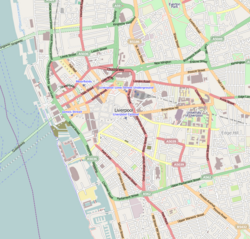St Peter's Church, Liverpool
| St Peter's Church, Liverpool | |
|---|---|
 St Peter's Church in 1800 | |
 St Peter's Church, Liverpool Shown within Liverpool | |
| 53°24′18.4626″N 2°59′3.9103″W / 53.405128500°N 2.984419528°WCoordinates: 53°24′18.4626″N 2°59′3.9103″W / 53.405128500°N 2.984419528°W | |
| Location | Liverpool |
| Country | England |
| Denomination | Church of England |
| History | |
| Consecrated | 29 Jun 1704 |
| Architecture | |
| Functional status | Demolished |
| Architect(s) | John Moffat |
| Construction cost | £3,500 |
| Demolished | 1922 |
| Specifications | |
| Height | 33 m (108 ft) |
| Number of towers | 1 |
St Peter's Church was the Anglican Pro-cathedral and Parish church of Liverpool. It was erected in 1700,[1] consecrated on 29 Jun 1704 and demolished in 1922. It was located on Church Street.[2] Its location is now marked by a bronze Maltese cross on Church Street.[3]
History[]
The first Oratorio to be performed in Liverpool was Handel's Messiah and was performed in St Peter's Church.
On 1 July 1880, J. C. Ryle was appointed as the first Bishop of Liverpool at which point St Peter's became the pro-cathedral of Liverpool.
The church was replaced as cathedral of Liverpool by the current Liverpool Cathedral.
The church's records are stored in the Liverpool Records Office.[4]
Architecture[]
The building was designed by John Moffat and was erected to the South of Church Street. The architecture of the pro-cathedral was criticised for being inconsistent; each of the doorways to the church were of different designs. The church had a single tower which measured 108 feet (33m) in height, the upper part of which was octagonal in shape and contained a peal of ten bells.
The church contained an oak altar which was greatly admired.[5] At the Eastern end was a stained glass window representing Saint Peter and at the Western end was a large organ.
The environment surrounding the church was criticised for being muddy; Church Street was not paved until 1760 and was the site of a weekly cattle market.
Gallery[]

Photograph from 1922

The plaque that now marks the former site of the church
References[]
- ^ Young, Henry S.; Young, Harold E. (1913). Bygone Liverpool. Liverpool: Henry Young And Sons. p. 49.
- ^ Lancashire OnLine Parish Clerks. "St Peter's Church, Church St, Liverpool 1704 - 1919". Lancashire OnLine Parish Clerks. Lancashire OnLine Parish Clerks. Retrieved 30 Dec 2016.
- ^ "Church St - Google Maps". Google Maps. Google. Jun 2014. Retrieved 30 Dec 2016.
- ^ "St. Peter's Church, Church Street". Liverpool Records Office. Liverpool Records Office. Retrieved 30 Dec 2016.
- ^ The Picture Of Liverpool. Liverpool: Thomas Taylor. 1834. p. 110.
External links[]
- Destroyed churches in England
- Buildings and structures in Liverpool
- Churches completed in 1700
- 1700 establishments in England
- Buildings and structures demolished in 1922
- 1922 disestablishments in England

